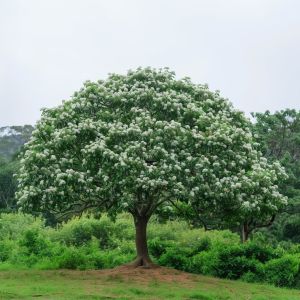Snowbloom Tree
The Snowbloom Tree, also known as Snowflower Tree, (Sorbus astralifera) is a deciduous tree known for its delicate clusters of small, white flowers that cover its branches like a fresh snowfall in spring. Native to temperate forests, this tree has a unique ability to produce a resin that transforms into a semi-precious gemstone called Starfire Amber, which is valued for both its beauty and its use in magical practices. Due to its distinct appearance and the valuable properties of its amber, the Snowbloom Tree plays a significant role in both local ecosystems and cultural traditions.
Appearance
The Snowbloom Tree (Sorbus astralifera) is a deciduous tree characterized by its medium height, reaching up to 10–15 meters (33–50 feet). The tree has a rounded canopy with dense foliage made up of pinnately compound leaves, which consist of 5–9 leaflets that are dark green on top and a lighter, silvery-green on the underside. The tree blooms in spring and early summer, producing clusters of small, white flowers that create the illusion of snow-covered branches, giving the tree its name. The flowers are subtly fragrant, attracting various pollinators, including bees and butterflies.
The bark is smooth and silvery-grey when young, becoming more textured and furrowed with age. During autumn, the leaves turn a range of colors from yellow to deep orange and red before falling, revealing the unique shape of the tree’s branches, which curve gently upwards.
Habitat
The Starfire Tree is native to temperate forests in regions with mild to cool climates. It is commonly found in the foothills and lower elevations of mountainous areas, particularly near rivers and streams where the soil is rich in minerals. These trees thrive in well-drained, loamy soils that have a slightly acidic to neutral pH. They are commonly found in regions of eastern and central Europe, the temperate zones of Asia, and parts of North America, particularly in areas with frequent mist or light rain that keep the soil moist.
The tree prefers partial sunlight to full shade and often grows as an understory tree in mixed deciduous forests. Starfire Trees are moderately resistant to cold temperatures and can tolerate light frost, but they do not thrive in areas with extremely hot or dry conditions.
Starfire Amber
Starfire Amber is a unique crystalline resin secreted by the roots of the Snowbloom Tree. The tree's roots naturally release resin, which slowly permeates the surrounding soil and mixes with various minerals. Over time, this mixture hardens into amber-like crystals, which can be found buried in the ground around the tree.
Starfire Amber is typically bi-colored, displaying shades of blue or cyan alongside hues of red, pink, or purple. These colors are due to the unique mineral composition of the soil in which the tree grows, and different shades can sometimes be found within the same gem. Occasionally, the amber may contain streaks of green, yellow, or even black, depending on local mineral variations.
These gemstones are highly valued for their beauty and rarity, as they are often harvested by carefully excavating the soil around the tree's roots. However, since the resin secretion is a slow process, the gemstones are considered semi-precious, and their availability depends on local harvesting practices and the tree's age.
Uses in Magic
Starfire Amber is prized not only for its aesthetic qualities but also for its use in magical practices. In regions where the Snowbloom Tree is native, the amber is often ground into a fine powder and used to create incense. When burned, this incense emits a pleasant, slightly sweet-smelling smoke that has mild psychotropic effects. Local magi and shamans use the incense during rituals to induce visions, enhance meditation, or connect with spiritual entities.
The unique properties of the amber are believed to help open the mind to hidden knowledge and unlock latent magical abilities. However, the use of Starfire Amber incense outside its native regions is strictly regulated due to its hallucinogenic effects. Some governments and magical councils have banned its use altogether, fearing potential misuse or dangerous side effects.
Regulations
Due to the psychotropic effects of Starfire Amber incense, there are strict regulations on its trade and use. In most regions outside its native habitat, the import, sale, or possession of Starfire Amber in any form is either heavily regulated or outright banned. Licensed magi and researchers may be granted limited access for scholarly or ritual purposes, but they must comply with stringent guidelines, including proper storage, usage documentation, and reporting of any effects.
Harvesting Starfire Amber also requires a permit to ensure that it does not harm the Starfire Trees or lead to overharvesting, as the trees are considered valuable not only for their magical properties but also for their ecological role in their native forests. Conservation groups have pushed for the establishment of protected areas where the trees can grow undisturbed, and there are ongoing efforts to cultivate Snowbloom Trees in controlled environments to lessen the impact on natural populations.
Conservation Status
The Snowbloom Tree is currently classified as a species of "Least Concern," but the overharvesting of Starfire Amber poses a potential threat to its long-term survival in the wild. Conservation efforts are focused on educating local populations about sustainable harvesting methods and promoting the cultivation of Starfire Trees in botanical gardens and reserves. There is also ongoing research into the propagation of the trees in non-native areas with suitable climates, which could reduce pressure on wild populations.

